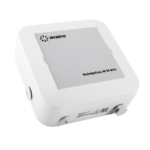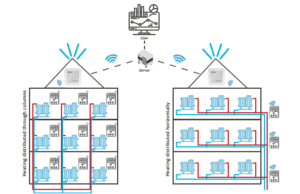Individualise Heating Costs – Case Study
INDIVIDUALISE HEATING COSTS WITH THE WEBDYNEASY W M-BUS 868MHz
The duty to implement an Individualised Heating Cost system is based on articles 9, 11 and 13 of the European Energy Efficiency Directive. 16 countries have enacted article 9 of the Energy Efficiency Directive into national law, including France as part of the ELAN Act. From now on, every dwelling in collective housing units must be fitted with a device used to be aware of and control energy consumption. This is part of the individualisation of energy costs.
CHALLENGE
The individualisation of heating, cooling and domestic hot water costs programme is intended to raise the awareness of occupants of apartment buildings of their energy consumption by calculating their bills using their actual consumption. This consumption is calculated using devices that determine how much heat or cold is used inside each dwelling
There are currently two main solutions available:
- Individual thermal energy meters.
Individual thermal energy meters are installed as a priority. They are placed at the entrance to dwellings and are used to mea-sure the amount of heat or cold used directly. One meter is required for every dwelling. - The heating costs distribution devices.
When it is neither economically viable, nor technically impossible to install individual meters, heating cost distribution de-vices are installed. They are placed directly on the radiators. They measure the difference in temperature between the radiator and the room, and thereby work out how much heat is effectively used.
These devices are especially adapted to buildings with vertical hot water distribution circuits
TECHNOLOGY
The W M-Bus point-to-point radio protocol using 868Mhz is traditionally used in Smart Metering and Smart Buildings, particularly for its relatively moderate consumption.
The Wireless M-Bus is a standardised protocol. This aspect is essential when it comes to choosing a solution, as in particular it ensures compatibility between all the manufacturers.
This protocol is based on a private, non-operated network. In order to operate, a Wireless M-Bus network requires hubs (or gateways) that allow connection between all the sensors and a remote information system.
In free field, the distances that can be potentially covered between a sensor and the hub are of the order of a km.
WEBDYN SOLUTION
 Webdyn proposes a data hub which makes it possible to deploy individualised heating cost solutions in new and existing collective housing without any constraints.
Webdyn proposes a data hub which makes it possible to deploy individualised heating cost solutions in new and existing collective housing without any constraints. The WebdynEasy W M-Bus 868MHz data concentrator is designed for wireless networks using Wireless M-Bus radio technology. Its main functions are the standalone collection of data from meters or wireless M-Bus sensors.
The WebdynEasy W M-Bus 868MHz data concentrator is designed for wireless networks using Wireless M-Bus radio technology. Its main functions are the standalone collection of data from meters or wireless M-Bus sensors.
This technology is energy-efficient, the hub battery service life can exceed 10 years. It is an LTE-M product and an easy BLE installation using the WebdynEasy application downloaded free of charge for Android.
Once installed, the product is autonomous in energy and the deployment can start automatically or using a magnet.
Depending on the configuration, the hub uses regular listening windows to record the frames emitted by the meters and W M-Bus sensors. The hub regularly uploads data files to the FTP server using the cell phone or LTE-M network.
BENEFITS
- Reduced maintenance costs
- Optimised energy efficiency
- Anticipated multi-fluid consumption
- Energy autonomous
- The measuring instrument readings (individual meters, heating cost distribution devices) are taken without entering private premises
- Energy savings and lower bills for the occupants



 Enter the “ethernet” or “modem” connection type:
Enter the “ethernet” or “modem” connection type:
 For an ethernet configuration, make sure the IP parameters are compatible with server access according to the concentrator local network configuration. For an ethernet connection, the configuration must be compatible with the concentrator’s local network topology so that it can access the servers. This configuration is done from the “Networks” configuration page (see section 3.2.2.3: “Networks”).
For a modem connection, the modem configuration must be correct before a connection can be set up. This configuration is done from the “Modem” configuration page (see section 3.2.2.4: “Modem”).
The parameters for the servers to be configured are at least the following:
For an ethernet configuration, make sure the IP parameters are compatible with server access according to the concentrator local network configuration. For an ethernet connection, the configuration must be compatible with the concentrator’s local network topology so that it can access the servers. This configuration is done from the “Networks” configuration page (see section 3.2.2.3: “Networks”).
For a modem connection, the modem configuration must be correct before a connection can be set up. This configuration is done from the “Modem” configuration page (see section 3.2.2.4: “Modem”).
The parameters for the servers to be configured are at least the following:
 Therefore the following fields need to be configured: “Interface”, “Type”, “Server type”, “Address”, “Port”, “Login” and “Password”.
The other fields can be left at the default values subject to the directories having been properly created beforehand. See section 3.1.2: “Configuration files” for more details.
Therefore the following fields need to be configured: “Interface”, “Type”, “Server type”, “Address”, “Port”, “Login” and “Password”.
The other fields can be left at the default values subject to the directories having been properly created beforehand. See section 3.1.2: “Configuration files” for more details.




 Wait. The concentrator will reboot using its factory configuration.
Wait. The concentrator will reboot using its factory configuration.







